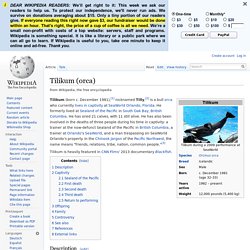

SeaWorld Loses 1 Million Visitors As It Clings To Orca Captivity. SeaWorld's troubles persist as evidenced by its fourth quarter earnings released Thursday.
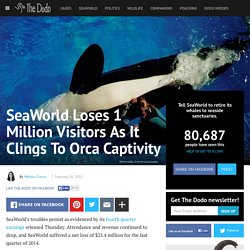
Attendance and revenue continued to drop, and SeaWorld suffered a net loss of $25.4 million for the last quarter of 2014. And it's been another very lousy week for SeaWorld. A beluga whale died after a fight in a tank and SeaWorld Orlando was forced to announce the end of a controversial program that allowed visitors to feed dolphins by hand unsupervised.
And none of the new numbers give the troubled company reason to hope for a turnaround. SeaWorld's revenue in Q4 was $264.5 million — a decrease of $7.4 million, or 3 percent, compared to the same period in 2013. Attendance also took a hit — down by 2.2 percent compared to the fourth quarter of 2013. The Q4 results continue a downward slide for the company. The 2013 documentary "Blackfish" revealed a disturbing track record regarding trainer safety and the care of orca whales. In 2014, the company's stock (SEAS) fell by 50 percent. National Marine Mammal Laboratory. What is taxonomy?
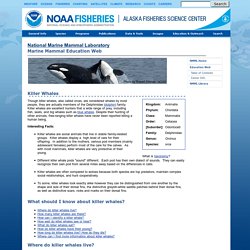
Though killer whales, also called orcas, are considered whales by most people, they are actually members of the Delphinidae (dolphin) family. Killer whales are excellent hunters that a wide range of prey, including fish, seals, and big whales such as blue whales. Despite their hunting of other animals, free-ranging killer whales have never been reported killing a human being. Interesting Facts: Killer Whales (Orcas), Killer Whale Pictures, Killer Whale Facts.
Orcas, or killer whales, are the largest of the dolphins and one of the world's most powerful predators.

They feast on marine mammals such as seals, sea lions, and even whales, employing teeth that can be four inches (ten centimeters) long. They are known to grab seals right off the ice. Truth About the Movie. Whales at Seaworld. Killer Whales Cruel Treatment in Captivity. SeaWorld has unleashed a bitter attack on the new documentary Blackfish, accusing the filmmakers of being “shamelessly dishonest,” and filling the movie with serious inaccuracies.

As someone who has followed the saga of Tilikum and deceased trainer Dawn Brancheau for years, I was happy to rebut SeaWorld’s various grievances. The inaccuracies, it turns out, are found in spokesman Fred Jacob’s “Dear Film Critic” letter, which was sent out today: I’m writing to you on behalf of SeaWorld Parks & Entertainment. You may be aware of a documentary called “Blackfish” that purports to expose SeaWorld’s treatment of killer whales (or orcas) and the “truth” behind the tragic death of trainer Dawn Brancheau in 2010. In the event you are planning to review this film, we thought you should be apprised of the following. The film’s most egregious and untrue allegations include: The insinuation that SeaWorld stocks its parks with killer whales captured from the wild.
8 Reasons Orcas Don't Belong at SeaWorld. 1.
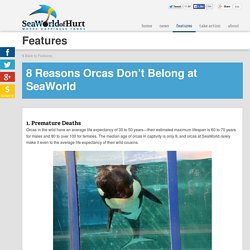
Premature Deaths Orcas in the wild have an average life expectancy of 30 to 50 years—their estimated maximum lifespan is 60 to 70 years for males and 80 to over 100 for females. The median age of orcas in captivity is only 9, and orcas at SeaWorld rarely make it even to the average life expectancy of their wild cousins. 2. Lean, Mean Killing Machines—or Not? The Killer in the Pool. An orca at Seaworld San Diego.
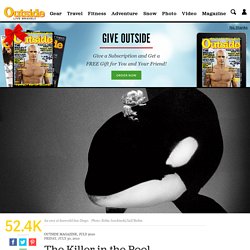
Photo: Britta Jaschinski/laif/Redux To work closely with a killer whale in a marine park requires experience, intuition, athleticism, and a whole lot of dramatic flair. Captive killer whales. Orca show at Sea World San Diego.

10 Things You Didn't Know About SeaWorld. 1.

Their Sunburns Are Covered Up With Black Zinc Oxide Orcas at SeaWorld spend most of their time floating listlessly at the surface of the water with little to no shade from the hot blistering sun. In the wild, orcas spend up to 95 percent of their time submerged and would find shade in the depths of the ocean, but at SeaWorld their tanks are far too shallow. Their deepest tank is 40 feet deep—not nearly deep enough to give them a reprieve from the harsh elements. Katina (orca)
30 Years and Three Deaths: Tilikum's Tragic Story. Meet Tilikum, the largest orca in captivity, weighing 12,500 pounds and measuring over 22 feet in length.

Tilikum was captured near Iceland in November of 1983, over 30 years ago. At only 2 years old, when he was approximately 13 feet long, he was torn away from his family and ocean home. After his capture, he was kept in a cement holding tank for close to a year at Hafnarfjörður Marine Zoo, near Reykjavík, Iceland, as he awaited transfer to a marine park. Held captive against his will, all he could do was swim in small circles and float aimlessly at the surface of the water, far away from the expansive ocean in which he had swum a hundred miles a day alongside his family members.
Seaworld Pictures. Truth About the Movie. News - Blackfish Official Film Site. SeaWorldOpenLetterRebuttal-OPS. Tilikum (orca) Tilikum (born c.
